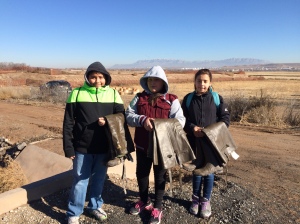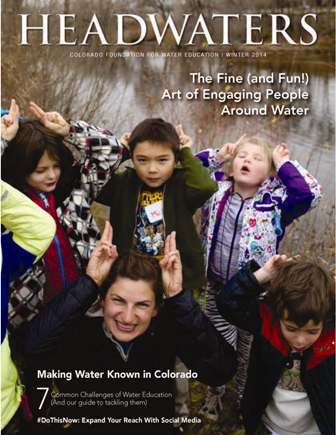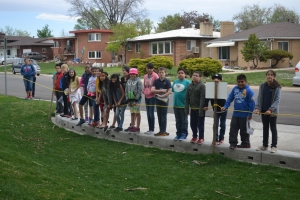By Lydia Hooper
What does it take to empower today’s youth to change their watershed? An entire community, says Donny Roush, Director of Uncommon Collaboratives and Program Director for Keep It Clean – Neighborhood Environmental Trios (KIC-NET) at the non-profit Earth Force.
“Young people are natural problem-solvers,” he said. “To better support them, KIC-NET seeks to bridge and address the needs of both urban stormwater and STEM education. The kids do the rest.”
For the past four years, Roush has leveraged funding from the EPA’s Urban Waters program and partnered with Denver Public Works to develop this transferable urban watershed education program.
KIC-NET aims to fulfill the city’s water quality requirements while also engaging students in STEM (Science, Technology, Engineering and Math) learning and supporting them to become life-long stewards of the South Platte River and other local bodies of water.

Truman Middle School students begin a day of water quality testing at the Valle de Oro National Wildlife Refuge by carrying waders into the Rio Grande bosque.
KIC-NET has been so successful in Denver that the program is now expanding from 10 to 25 schools in the metro area – and it’s going national (read about the program’s beginnings in this 2012 post) . Last fall, KIC-NET was adopted in Albuquerque, New Mexico, where partners have empowered 300 students at five schools to take ownership of the Middle Rio Grande watershed.
From river conservation organization Amigos Bravos and the Valle del Oro Wildlife Refuge to the City of Albuquerque and Ciudad Soil and Water Conservation District, partners are collaborating to achieve the common goal of healthier waters and communities.
“The Valle de Oro National Wildlife Refuge strives to maintain the reputation of being an outdoor classroom for Albuquerque’s youth and the KIC-NET program is doing just that,” says Julia Bernal of the Valle de Oro National Wildlife Refuge. “We love hosting Albuquerque’s young students and educators to promote environmental education and awareness.”
KIC-NET schools use nearby waterways and parks as outdoor teaching opportunities to both investigate and make plans to improve their neighborhood waters themselves. For example, last year fifth-graders at Math and Science Leadership Academy (MSLA), in Denver, CO, created and distributed brochures about a city water quality improvement project to neighbors in the watershed of their Huston Lake.
KIC-NET schools also benefit from utilizing the experts and resources provided by partnership. Educators receive training and an activity guide that provides 32 place-based lessons aligned to the Earth Force Process, a six-step instructional model that combines the best of action civics, service-learning, and STEM learning. Using the Process, students work together to design and implement a project that addresses an issue that they care about in their school or community.
Through KIC-NET, students begin to understand the importance of their role as a leader in their community. “I think [our KIC-NET project] was [important] because if we didn’t go door-to-door then maybe Huston Lake would have even more trash,” said Eric Montez, a student at MSLA.
KIC-NET is not only expanding beyond urban Denver to the suburban areas surrounding Cherry Creek and Bear Creek, but cities as far away as Youngstown, Ohio are interested in reaping the mutual benefits of this model.
“For the past three years, we have been sharing the concepts behind the KIC-NET model with the Colorado Stormwater Council and surrounding communities,” says Darren Mollendor, KIC-NET co-creator and engineer at Denver Public Works. “We are encouraging cities across the state to capitalize on existing assets and infrastructure to use them not just as a feature in the environment but as an environmental learning tool.”
Earth Force is hosting a free KIC-NET workshop for educators on March 11, 2015 in Denver, Colorado. Those interested can contact Program Coordinator Erika Rodriguez at erodriguez@earthforce.org. You can find more information on KIC-NET here.
 Lydia Hooper has been a “Keep It Clean” communications consultant for Earth Force in partnership with Denver Public Works since 2012. As a freelance creative strategist, she helps mission-driven organizations connect and engage by creating strategic, meaning-rich content. With a multidisciplinary background and versatile skills, she specializes in presenting complex ideas and information in ways that create real impact.
Lydia Hooper has been a “Keep It Clean” communications consultant for Earth Force in partnership with Denver Public Works since 2012. As a freelance creative strategist, she helps mission-driven organizations connect and engage by creating strategic, meaning-rich content. With a multidisciplinary background and versatile skills, she specializes in presenting complex ideas and information in ways that create real impact.
Interested in water education? Check out the Winter 2014 issue of Headwaters  magazine “The Fine (and Fun!) Art of Engaging People Around Water” and register for the Water Educator Symposium the afternoon of March 11, 2015 for more examples of successful educational programs and opportunities to collaborate with water educators around the state. If you aren’t a member already, look at the resources available and join the Water Educator Network here.
magazine “The Fine (and Fun!) Art of Engaging People Around Water” and register for the Water Educator Symposium the afternoon of March 11, 2015 for more examples of successful educational programs and opportunities to collaborate with water educators around the state. If you aren’t a member already, look at the resources available and join the Water Educator Network here.


 Print
Print
Reblogged this on Coyote Gulch.
One of the better pieces i have read this week.